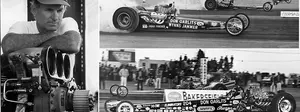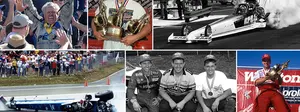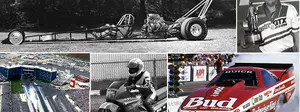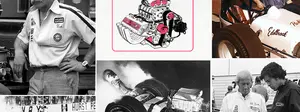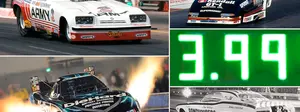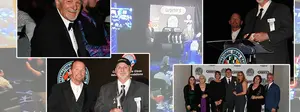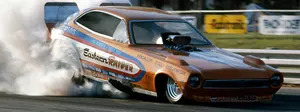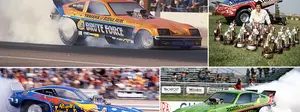
In case you missed the announcement today on NHRA.com, we’ve revealed the final Top 20 list of Funny Cars from which fans can vote over the next six weeks or so, so welcome to a early edition of the Dragster Insider to help you make your choice. The voting, part of NHRA’s 50 years of Funny Car celebration this season, asks fans to vote for the car that they think has been the most important/influential/successful in the class’ long history.
As I discussed here last week, a tremendous amount of effort and care went into creating the list, weighing fan input and the criteria put upon our panel of experts, and I’m very happy with the final list, even though not all of my 20 made it to the final ballot.
So here’s a quick overview of the list, in chronological order:
Don Nicholson Eliminator I Comet (1966)

The sport’s first flip-top car, it forever changed the basic look of the class: a tilt-up body hiding a tube-frame chassis and a thumping nitro engine. The car was a terror on the track, too, challenged only by Mercury teammate Eddie Schartman.
Jack Chrisman Comet (1967)

Two years after blowing fans away with his original stock-appearing nitro-burning Comet at the 1964 Nationals, Chrisman’s lightweight flip-top Comet, with considerable engine setback, ran 190-mph speeds.
Chi-Town Hustler Charger (1969)
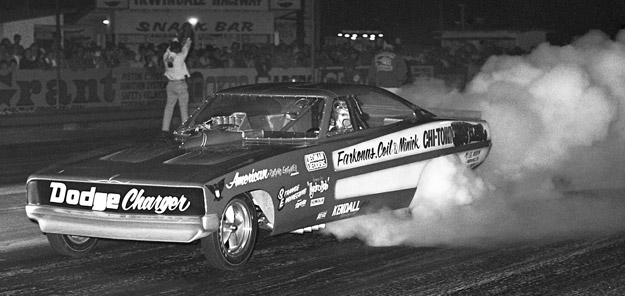
The car largely credited with creating the performance-enhancing burnout was a popular and successful match race machine with Pat Minick at the wheel and Hall of Famer Austin Coil turning wrenches.
Danny Ongais/Mickey Thompson Mustang (1969)

Built by Pat Foster, this car popularized the narrow-framerail chassis and dragster-style roll-cage design still used today. The car, along with Foster’s twin, was the first to use zoomie headers. The car won both the Springnationals and Nationals in 1969.
Ramchargers/Goldstein Dodge Challenger (1970)

The Ramchargers brought its engine savvy to the Funny Car class after years in Top Fuel and created a winning combination with driver Leroy Goldstein. The car broke the six-second barrier in June 1970.
Don Prudhomme Hot Wheels Barracuda (1970)

“The Snake” and partner Tom McEwen brought Corporate America to the dragstrip through their deal with Mattel-backed Funny Cars, and the former dragster drivers became household names and brought drag racing into living rooms around the world.
Gene Snow Rambunctious Challenger (1970)

“The Snowman’s” direct-drive Dodge was the unchallenged king of top speeds in the late 1960s and early 1970s and enjoyed success in multiple sanctioning bodies, including a three-win NHRA season that culminated in the class’ first NHRA world championship.
Ed McCulloch Revellution Duster (1972)

This car, backed by Revell, maker of plastic model cars, really put “the Ace,” already a successful Funny Car pilot, on the map by winning four of eight events in 1972: the first three and the U.S. Nationals.
Pat Foster/Barry Setzer Vega (1972)

Although Foster’s national event statistics don’t bear it out, the pretty maroon and gold Vega, owned by textile magnate Setzer, was the baddest Funny Car on the planet in 1972-73, running low e.t. almost everywhere it went.
Jim Dunn/Dunn & Reath Barracuda (1972)

The first and only rear-engine Funny Car to win a national event (1972 Supernationals), the car also was the star of a feature film,
Funny Car Summer, that exposed the masses to the sport. The combination of savvy Dunn’s handling skills and a Woody Gilmore design opened up endless possibilities, but their success was never duplicated.
“Jungle Jim” Liberman Vega (1973-74)

Drag racing’s premier showman wowed fans from coast to coast with this car, performing crowd-pleasing fire burnouts and racking up an impressive win-loss record on the match race scene.
Don Prudhomme Army Monza (1975-76)

On a per-race basis, one of the most successful cars to compete, winning 13 of 16 events and two championships in 1975-76. The car also made the sport’s first five-second Funny Car pass.
Raymond Beadle Blue Max Mustang II (1975)

Beadle went from journeyman racer to superstar with the resurrection of the famed Blue Max name and was Don Prudhomme’s toughest rival in the mid- to late 1970s.
Dale Pulde War Eagle Trans Am (1977)

One of the prettiest cars to ever grace the dragstrip and a steady performer in multiple series. The car set the NHRA national speed record at 245 mph.
Don Prudhomme Pepsi Challenger Trans Am (1982)

The first Funny Car to exceed 250 mph, it carried “the Snake” to two wins in 1982 and one of the greatest runs in class history, a stunning 5.63 clocking at the U.S. Nationals.
Kenny Bernstein Budweiser King Tempo (1984)

Bernstein and crew chief Dale Armstrong spent hours in the Ford wind tunnel perfecting the aero shape of this car with rounded fenderwells, a full belly pan, enclosed side windows, and more, beginning an attention to aero detail that continues to this day.
Kenny Bernstein “Batmobile” Buick (1987)

Bernstein and Armstrong broke the mold – almost literally – with this car that took advantage of every loophole in the Rulebook with a wider and higher rear deck that created a lot of downforce with very little aerodynamic drag. Ugly to a fault but beautiful in results, the car was legal only for one season, but the ideas it inspired live on.
Jim White/Hawaiian Dodge (1991)

Any number of Roland Leong’s Hawaiian entries could have made this list, but the White-driven Hawaiian Punch Daytona was a standout, running the class’ first 290-mph pass and winning both the Big Bud Shootout and U.S. Nationals in the same weekend en route to a second-place championship finish.
John Force Castrol Firebird (1996)

Another driver who could have had multiple cars on the list, Force set class records in 1996 with this entry, scoring 13 wins in 19 events en route to yet another championship.
Jack Beckman Infinite Hero Dodge (2015)
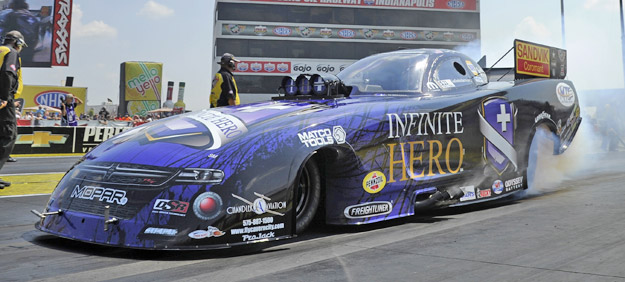
Beckman and crew chief Jimmy Prock shook up the Funny Car ranks in mid-2015, moving the needle on what had been a stagnant performance barrier and not only repeatedly lowering the class e.t. mark but also inspiring the rest of the class to follow suit, leading to unprecedented leaps in performance over four months.
That’s quite an impressive list spanning the history of the class, and so many more could have -- and some might argue, should have – been on the list.
Among those that just missed cracking the top 20 are (in no particular order) Cruz Pedregon’s McDonald’s Olds Cutlass (1992); the Joe Pisano/Mike Dunn Cutlass (1988-90); the Pisano & Matsubara Vega (1973-74); Pulde’s Miller High Life Warrior Buick Somerset (1985); Tom McEwen’s Hot Wheels Duster (1970) and Indy-winning English Leather Corvette (1978); the Frank Hawley-driven Chi Town Hustler Charger (1982); the Mark Oswald-wheeled Candies & Hughes Pontiac (1984); the Gary Dyer-driven Mr. Norm’s Dodge; Liberman’s ’66 Chevy II and '69 Nova; the Stardust Mopars of Don Schumacher (1969 and 1973) and Schumacher’s aero-trick Wonder Wagon Vega (1973); Bruce Larson’s USA-1 Camaro (1970) and his championship-winning Cutlass (1989); Beadle's Blue Maxes from 1978 and 1981; Tom Hoover’s Showtime Corvette (1976); Tony Pedregon's championship-winning Castrol GTX Mustang (2003); Gas Ronda’s Russ Davis Ford Mustang (1968); Jim Epler’s Rug Doctor Cutlass, which broke the 300-mph barrier (1993); Chuck Etchells’ Kendall Dodge, the first in the fours (1993); McCulloch’s Miller High Life Cutlass (1988); John Mazmanian’s Rich Siroonian-driven Barracuda (1971); the Beach City Corvette (1968-69); and Matt Hagan’s Mopar Express Lane Charger (2015).
So, there you have it. Voting on NHRA.com runs through early May, so weigh in. As the list order is revealed, we can discuss the pros and cons of each throughout the season. I’m sure you guys will have plenty to say. Let’s hear it!
And, of course, GO VOTE!


















































